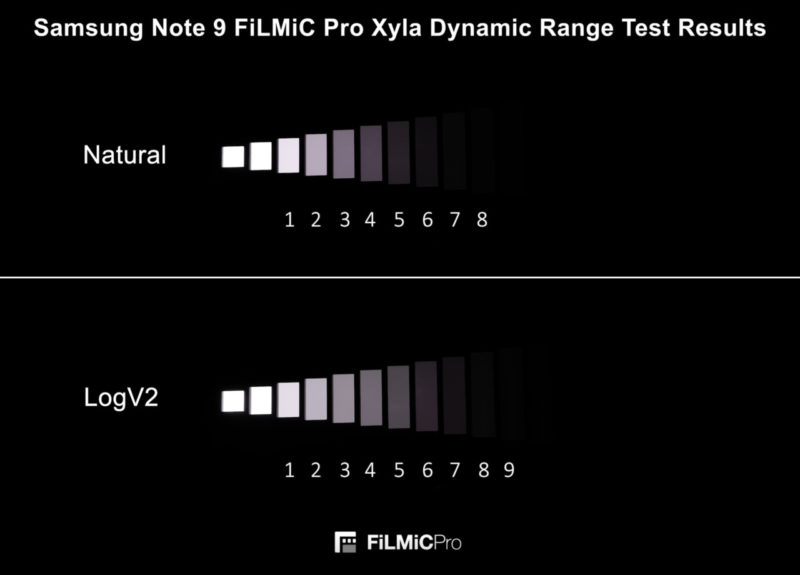FiLMiC Pro – Pro Log V2. More Dynamic Range from your phone
FiLMiC Pro now features LogV2 gamma curves which FiLMiC say add up to 2.5 extra stops of dynamic range.
They’re also offering a free LUT pack, aimed to give you the most from using their FLAT and LOG settings in the (optional $ extra) Cinematographer Kit. They gave you increased dynamic range and they’re gonna help you use it. Their “deFlat” and “deLOG” LUT pack converts your footage to a rec.709 color space.
Check out Patrick Tomasso’s test here (from 01:16), which really shows an extra “brightness” of the image, bringing out details from the shadows. He’s using an iPhone X.
What do you think of the graded versions though? To my eyes, those shadows with lack of detail reappear in many of the shots.
“The first thing to keep in mind when viewing the uncorrected vs. corrected video, is that the process creating the values that are encoded into the final file is computational. The luminance and chrominance are treated quite independently in the process. This means FiLMiC LogV2 doesn’t look desaturated as you would expect log encoded video to look.” Richard Lackey.
Check out Richard’s full article on how he is working with the new LogV2 and how it works differently to normal log video.
It’s important to remember, whatever magic FiLMiC does to your smartphone camera, you will still be working with 8 bit video as a result. But it’s squeezing out a bit (pun pun) extra…
“In the case of LogV2, we use this high-precision environment to construct a luma-map from the 8-bit source. Because the luma-map is derived from a flattened 24-bit RGB vector, the resulting fidelity exceeds the 8-bit precision of the individual Red, Green, and Blue elements.” Chris Cohen, FiLMiC Pro.
FiLMiC engineers say their app “recontructs” the image to give you more apparent detail. Chris goes on to say:
“With LogV2, we have chosen to abandon linearization and embrace the dynamic nature of the iOS pixel buffer stream.”
But what about Android?

This is FiLMiC Pro’s own dynamic range test on a Samsung Note 9. Richard says: “The Samsung Note 9 has a native base dynamic range of approx 7 stops when HDR is deactivated. With FiLMiC LOG v2 they claim to able to offer approx. close to 9 stops of dynamic range.”
Somewhat less impressive than what they are achieving with the iPhone.
Finding detail in the shadow is what it’s all about. As you can see from iPhoneographers tests:
A Great Tool Got Better
FiLMiC Pro is a great tool that has made many great movies shot on iPhones possible.
But I’m an Android user, shooting with a Samsung S9. And I’ve tried using flat and log, but wasn’t happy with what I ended up with. So I switched back to using natural and adding some tweaks in the colour when editing.
I’m happier with the results shooting natural. But this is in part down to me not wanting to spend the time on it.
For me, the advantage of shooting with a phone is the speed. If I have to spend extra days/hours tinkering with LUTs and colour wheels, then it seems to be defeating my reason for filming with a smartphone.
But if you love grading and colour correction, or you just want to practice the art before upgrading to more pro cameras (better suited to this filming-editing workflow) then this FiLMiC Pro is for you.
If you are serious about using Log colour when shooting smartphone videos, I really recommend you read my ppst on this. The truth about Log format shooting is not as simple as it might seem: LOG-FORMAT ON A SMARTPHONE – BASICS EXPLAINED
Freestyle
I was chatting to Jason Cotterell about the development of their new camera app, called Nizo. He told me “we actually had more advanced camera tools, exposure zebra, focus peak – but the creatives found them a distraction, preferred to trust their eye, more freestyle…”
For me, this is a more exciting way of looking at smartphone filming (Nizo is currently only available for iPhone). Rather than mimic DSLRs, they are looking at the smartphone as a device that has its own filmmaking personality. Namely, fluidity and an opportunity to promote a more instinctive way of shooting and editing video.
The future of video is going to be about speed – simply because we can no longer afford to spend the amount of people-hours creating content we have done in the past. DSLRs have speeded things up, compared to shooting on film, for example. Smartphones could take it a step further and outdo DSLRs for speed of use – but not if we are trying to mimic DSLRs (which are, in turn, often trying to mimic film).
With VOD and YouTube being our primary avenues as filmmakers, and with an avalanche of content out there, we need to compensate for the reduction in reward. In other words, we need to make films faster. We can make films faster by reducing the technicality of the process and connecting to our instincts, thereby making the process more fluid.
Eager to learn more?
Join our weekly newsletter featuring inspiring stories, no-budget filmmaking tips and comprehensive equipment reviews to help you turn your film projects into reality!
Simon Horrocks
Simon Horrocks is a screenwriter & filmmaker. His debut feature THIRD CONTACT was shot on a consumer camcorder and premiered at the BFI IMAX in 2013. His shot-on-smartphones sci-fi series SILENT EYE featured on Amazon Prime. He now runs a popular Patreon page which offers online courses for beginners, customised tips and more: www.patreon.com/SilentEye

